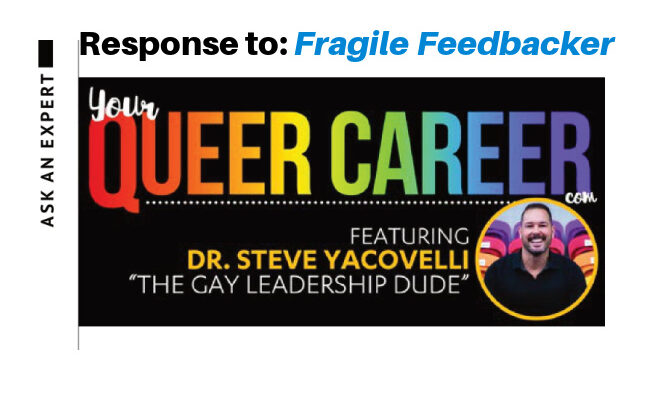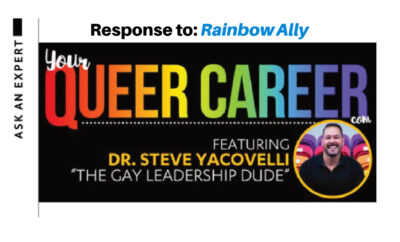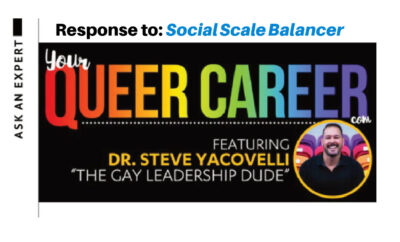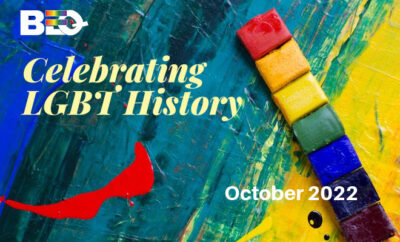
Ask An Expert
Q: Giving Effective Feedback to Team Members
By Steve Yacovelli, Ed.D.
Spring 2022 BEQ Pride Published May 4, 2022
Hello “Gay Leadership Dude®”: I’ve worked with a certain co-worker/teammate for about two years now. They’re nice enough, BUT they make these annoying gross generalizations about my work. “You’re always late!” or “I don’t think that meeting you ran was effective.” I don’t think they’re trying to be mean (well maybe a little), but I do wonder if there’s anything I can learn from their perception. How can I get “good” feedback from them that I can use versus criticizing?
~ Fragile Feedbacker
Ahh, Fragile Feedbacker, I get a lot of questions from my coachees and leaders on what is “effective feedback” and how to give it. Often in a workplace people come up to you and say, “Hey! I have some feedback for you” and our knee-jerk reaction is “Oh poop. I don’t really want to hear this.” Funny though: I was always taught that “feedback is a gift,” and like every gift we should smile and say thanks, even if we don’t like the feedback given. Ideally, your emotional reaction should be from “OK” to “Cool! Bring it on!”
There are some best practices on giving effective feedback, FF, that you can share with your somewhat jerky teammate. First: there’s a quick flow on how to give effective feedback so it’s meaningful (and actionable) to the recipient. It’s a simple model (there are lots of others out there), but I tend to use this one the most: The EECC Model for Effective Feedback (or E²C² if you’re feeling mathy):
E — EXAMPLE … Here we share a specific example of what happened. “Fragile, when you led our all-ERGs meeting yesterday…” Cite a specific example of the feedback you’re about to give.
E — EFFECT … What did the “feedbacker’s” actions, words, or behaviors do to you and/or others within the workplace? “…you [Fragile] forgot the last three agenda items during the meeting, making us have to circle back to the other ERG leads to get the information we needed for our project, and now we’ll have a delay…”
C— CHANGE … or … C — CONTINUE … This is where the model splits. When you’re giving feedback, it tends to fall into one of two camps: CHANGE is saying the behavior you did should be, well, changed; or CONTINUE is “you’re doing a good job … keep it up!” To finish our example: “…so in the future, I’d suggest you either manage the conversation to be sure you meet all the agenda items or schedule two meetings to get the information needed.” You never have the same feedback with both CHANGE and CONTINUE (we’ll talk about the “Feedback Sandwich” a bit later).
Here’s a CONTINUE E2C2 example: (E) “Fragile, when you led our all-ERGs meeting yesterday…” (E) “…you did a great job managing all the conversations and getting through the agenda with even five minutes to spare; getting us all the info we needed to work on our part of the project…” (C) “…perhaps in the future you should run all the meetings! Keep up the great work.”
It’s a simple model but can really go far in making sure your colleague is sharing all the information with you so you can actually act on their gift of feedback.
In addition to E²C², here are some additional tips for providing effective feedback to share with your colleague, Fragile:
- Feedback should be balanced … By “balanced” we mean a good combination of the CHANGE and CONTINUE feedback with the recipient. If you’re always using the word “feedback” with the likes of “Can I share some feedback? You stink at…” you’ll condition the recipient to associate “feedback” with “bad behavior” (Google Pavlov and his dogs). Plus: you don’t want to only point out the CHANGE stuff: acknowledge the CONTINUE, too! Share both types of feedback equally with the recipient.
- Feedback should be timely … “Fragile: that meeting you ran six months ago was great!” doesn’t do the recipient a lot of good to continue or change their behavior. By being timely you give that gift of feedback to the recipient to do with what they will; by not being timely you short-change them from applying your feedback. Also, be mindful of the when: if someone bombs at something it’s probably not the best leadership strategy to point it out to them 20 seconds afterward. Use your empathy to gauge when is the right time to share your gift of feedback.
- Feedback should be about behavior … “Fragile: you’re not very creative!” isn’t feedback that they can really use; it’s more of a character comment. Effective feedback should be on behavior that the individual can change or continue. BONUS: feedback is best when YOU observed the behavior, not the “Fragile: Bob in Accounting was in your ERG meeting, and he said…” as you’ve moved more into hearsay territory. Bob has feedback for Fragile? Have BOB share it directly with them!
- “Praise in Public, Criticize in Private*” … This is a strategy that—overall—is a good one to abide by; but notice the big legal asterisk on it. Sure: keep that CHANGE feedback in private—unless it’s great learning for everyone else. “Fragile: when you mismanaged our ERG meeting the other day; I’d like to share what we learned and what NOT to do with the team. Is that cool?” Ask permission first and if it’s given, share the feedback in public. Conversely: only praise in public when you know the recipient is OK with being in the spotlight. Some people hate to be called out for good work; so be sure to get to know those you work with and ask them if they are good with the accolades in public when warranted.
- Avoid “The Feedback Sandwich” … Another often-(mis)used strategy is “The Feedback Sandwich,” where you provide a top “bun” of positive feedback (“Fragile: you did a great job running our ERG meeting today…”) followed by negative “meat” in the middle (“…however, you missed three agenda items…”) and close with that bottom “bun” of positive feedback (“…but overall nice job on running that meeting!”). The “Sandwich” —while popular—is a really sloppy (Joe?) way to give feedback for two reasons. First: the feedback recipient could walk away just remembering the last “bun” of positivity and forget the “meat” negative stuff (that really can help them be better); or if I use this method all the time with people, they will disregard the first “bun” of feedback, waiting for the “however” or “but”, and this could erode trust with the recipient.
If done effectively, feedback can be a fantastic way to build relationships with those you work with. Creating a feedback-rich workplace also helps us correct some of those hidden biases and bad behaviors we may not even be aware of acting upon while continuing the good stuff. And frankly, it’s one of the best ways to foster trust within your workplace if you’re sharing feedback from a “we all want to improve” versus the “I’ll knock you down so I feel better about my performance!” position.
Fragile, share these tips with your colleague, and perhaps the next time they have feedback for you, you’ll have a gift that you can do something with.
HAVE A QUESTION FOR “THE GAY LEADERSHIP DUDE”? Submit @ www.YourQueerCareer.com Please note the advice shared is for informational use only; it is not intended to replace or substitute any mental, financial, medical, legal, or other professional advice. Full disclosure can be found at the website listed above.
FOR MORE INFORMATION:
Dr. Steve Yacovelli, Owner & Principal
TopDog Learning Group, LLC
+1 888.570.2228
Business Equality Pride (BEQPride) is the first publication from the BEQ family of national print and digital magazines exclusively addressing the needs of LGBTQ small-to-medium sized businesses, entrepreneurs and professionals.

















0 comments